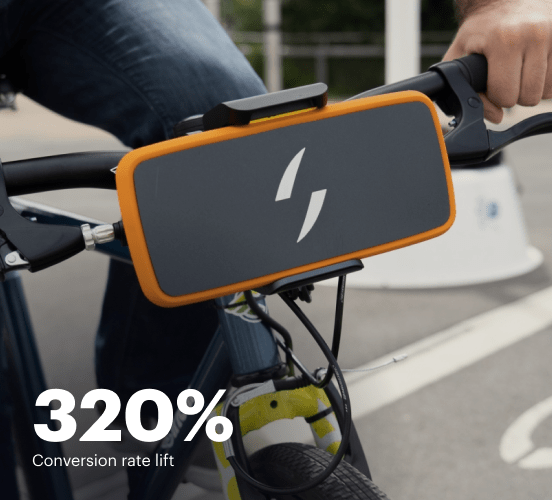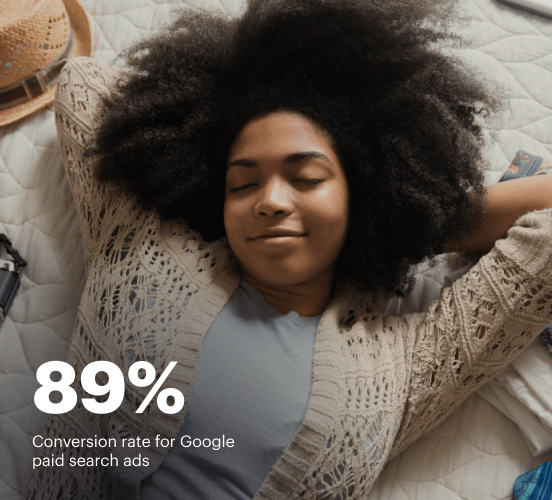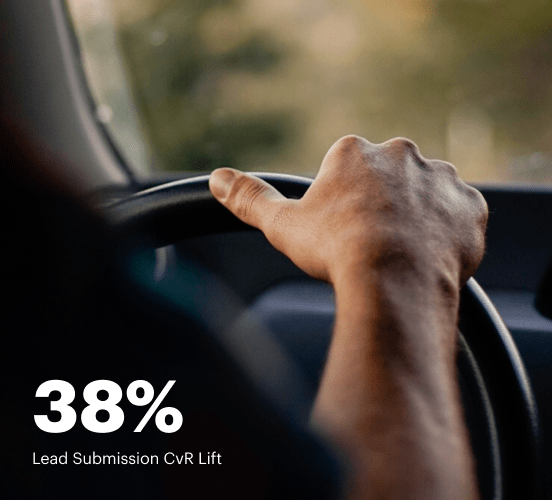Microsoft Forms vs. Canva: the best platform for a seamless web experience
Discover how Microsoft Forms compares to Canva regarding features and usability. Find out which platform provides the competitive advantage your business deserves.
Get startedSee how Instapage stacks up against the competition
| Feature | Instapage | Other builders |
| Drag-and-Drop Tools | ||
| Conversion-optimized templates | ||
| Manual and AI-powered A/B Tests | ||
| AI content suggestions | ||
| Popups and sticky bars | ||
| Canvas and grid blocks | ||
| Reusable and global elements | ||
| Form and popup builders | ||
| Built-in Heatmaps | ||
| Central analytics dashboard | ||
| Ad-to-page personalization and collections | ||
| Contacts, lists, and email | ||
| Dedicated, full-service CRO experts | ||
| Enterprise-ready platform |
Leading the way in building high-performing landing pages





Why Instapage is the smarter choice for your campaigns
Get everything you need to build, scale, and optimize high-converting landing pages—without coding.

Easier page building without coding
Instapage offers a flexible and seamless page creation experience with a library of 500+ conversion-focused layouts, Instablocks®, a drag-and-drop builder, and AI content generation. With technologies like Thor Render Engine®, you can create on-brand, mobile-responsive landing pages that load quickly and start converting during initial visitor clicks.

More insights — better results
Instapage lets you see in detail how each landing page experience and variation is performing so you can make targeted changes that boost page conversions. Use heatmaps for a better understanding of on-page activities, run A/B tests and AI-assisted experiments, and then track and evaluate results within robust analytics dashboards.

More personalized experiences
Instapage lets you quickly create high-performing landing pages tailored to each of your ad campaigns. Deliver personalized experiences for distinct audiences using dynamic text replacement. Effortlessly align specific advertisements to unique pages with AdMaps. Monitor audience-level metrics using our advanced data tools.

Built-in collaboration
Instapage collaboration capabilities bring your entire team together to speed up the process of landing page review, approval, and launch. No more frustrating and unnecessary revisions or edits scattered across emails. Provide instant feedback, conduct real-time page edits, and securely share your pages with outside stakeholders.

Free up time for your business
Invest time into business growth, not busy work. Launch landing pages faster with reusable forms and templates. Build once, reuse forever.
Explore all integrations






Easier page building without coding
Instapage offers a flexible and seamless page creation experience with a library of 500+ conversion-focused layouts, Instablocks®, a drag-and-drop builder, and AI content generation. With technologies like Thor Render Engine®, you can create on-brand, mobile-responsive landing pages that load quickly and start converting during initial visitor clicks.
More insights — better results
Instapage lets you see in detail how each landing page experience and variation is performing so you can make targeted changes that boost page conversions. Use heatmaps for a better understanding of on-page activities, run A/B tests and AI-assisted experiments, and then track and evaluate results within robust analytics dashboards.
More personalized experiences
Instapage lets you quickly create high-performing landing pages tailored to each of your ad campaigns. Deliver personalized experiences for distinct audiences using dynamic text replacement. Effortlessly align specific advertisements to unique pages with AdMaps. Monitor audience-level metrics using our advanced data tools.
Built-in collaboration
Instapage collaboration capabilities bring your entire team together to speed up the process of landing page review, approval, and launch. No more frustrating and unnecessary revisions or edits scattered across emails. Provide instant feedback, conduct real-time page edits, and securely share your pages with outside stakeholders.
Free up time for your business
Invest time into business growth, not busy work. Launch landing pages faster with reusable forms and templates. Build once, reuse forever.
Explore all integrationsGet started with Instapage in a few steps
-
Create your Instapage account
Start with Instapage by signing up via Google or your email. You'll get access to a free 14-day trial to discover Instapage capabilities. Feel free to cancel anytime during the 14-day trial if you decide that our product is not suitable for your business. -
Build and personalize your page
Create your first landing page from scratch or choose a template from 500+ customizable layouts. Use the drag-and-drop builder to add page elements, fonts, and backgrounds, refine content with AI, or add custom HTML, Javascript, and CSS. -
Review and make edits
Collaborate on page designs and streamline review processes. Invite your team members and stakeholders to review, edit, and provide feedback on your landing page. Collaborate knowing your page is confidential and only accessible to authorized users. -
Publish and track page performance
Publish your page to a domain or custom URL. Connect your pages to the ads you've created and track page performance within the analytics dashboard, run A/B tests and AI experiments, analyze results, and continuously optimize your landing page to maintain high conversions.
Microsoft Forms vs. Canva: A Comparatively Colorful Clash
In the ever-evolving landscape of digital tools, choosing the right platform can feel like navigating through a maze—especially with heavyweights like Microsoft Forms and Canva vying for the spotlight. Both platforms offer unique functionalities that promise to captivate users, making the decision even more challenging. Microsoft Forms, well-regarded for its streamlined survey creation, stands in stark contrast to Canva's vibrant design capabilities. This article will illuminate not only their individual strengths but also how they stack against a lesser-known competitor, Instapage, which is lurking just offstage. The showdown promises to be informative and entertaining, combining side-by-side comparisons with witty insights that make the exploration of these platforms not just useful but engaging.
Introducing the Titans of Digital Marketing
When it comes to online platforms for forms and design, Microsoft Forms and Canva aren’t just players; they are titans in the digital marketing ring. Microsoft Forms has become a go-to solution for those needing quick, efficient survey tools that integrate seamlessly with the rest of the Microsoft ecosystem. It allows users to collect valuable data with ease and efficiency. On the other hand, Canva electrifies the scene with its user-friendly design capabilities, empowering marketers, educators, and small business owners to create stunning visuals, brochures, and presentations, often with little to no design experience. Both platforms have carved out significant niches within the digital marketing domain, drawing loyal users with their compelling features. But, as we move deeper into this comparison, one must wonder if Instapage—often overshadowed by these giants—could actually provide the refined edge that some users are seeking.
Feature Showdown: What Sets Them Apart
As we enter the feature smackdown round, it’s clear that Microsoft Forms and Canva both come armed with impressive toolkits. Microsoft Forms prides itself on offering essential features like automatic data collection, branching logic for surveys, and real-time analysis, making it a top choice for data-driven marketers. Meanwhile, Canva counters with its extensive library of templates, drag-and-drop functionality, and design elements, making it a beacon for those looking to create visually compelling content. Amid this robust competition, Instapage sits in the wings, polishing its own unique features tailored for landing pages, conversions, and tailored marketing campaigns. The tale here is not just about who has more features, but rather who aligns best with your particular marketing strategy.
Usability Face-off: Who Makes It Easier?
When discussing usability, it becomes essential to consider the different audiences each platform serves. For Microsoft Forms, the navigation is smooth and simple; even first-time users can set up a survey in minutes. Canva also holds a reputation for its ease of use, guiding newcomers with intuitive design prompts and assistance. However, there’s a learning curve, akin to engaging in a beginner’s boxing match—sometimes delightful and other times a little awkward. A humorous glance at this comparison might reveal how both platforms strive for accessibility but cater to varying levels of expertise; devoted users can see the potential in both but might find the journey to mastery rather amusingly bumpy.
Must-See Features of Microsoft Forms:
- Quick survey creation with user-friendly templates
- Real-time response tracking and insights
- Integration with Microsoft 365 applications
- Customizable branching logic for tailored responses
- Data export options to Excel for deeper analysis
Top Features of Canva:
- Drag-and-drop interface for effortless design
- Extensive library of customizable templates
- Collaboration tools that enhance teamwork
- Access to thousands of stock photos, graphics, and fonts
Common Strengths of Both Platforms:
- Cloud-based access for flexibility
- User-friendly designs that accommodate beginners
- Mobile-friendly options for on-the-go use
- Real-time collaboration features
- Wide range of integrations with other software tools
- Community resources and tutorials for learning
With both platforms swinging hard in the feature ring, it's noteworthy how they stack up against Instapage, which brings an even sharper focus on conversions and seamless integrations. Both Microsoft Forms and Canva are impressive, but Instapage offers the fine-tuning variety in functionality that might just make it the superior choice for performance-driven individuals and businesses.
Performance Perspective: Speed and Responsiveness
As we evaluate performance, the focus shifts to loading times and mobile optimization—a crucial factor in user experience. Both platforms have commendable records; however, like molasses in winter, slow-loading pages can leave users feeling frustrated and discouraged. Microsoft Forms gets high marks for its ability to load quickly and accommodate an influx of submissions during busy periods, allowing for effective data management. On the other hand, Canva performs exceptionally well on mobile, making it easy for users to design, edit, and share graphics on the go. With such capabilities, neither platform falls short, but when weighed against Instapage's rapid loading times specifically designed for landing pages, users may find just the right speed in the marketing arena.
Support Systems: Who's Got Your Back?
No platform is complete without robust support, and in this round, we need to evaluate how Microsoft Forms and Canva hold up. Both offer extensive help centers, tutorials, and community forums—but which one wins the support award? Microsoft Forms users can access direct assistance from Microsoft support, with a wealth of resources for real-time question handling. Canva provides its extensive help center and community forums, as well as rapid chat support for issues that need solving quickly. However, in the shadows stands Instapage, known for its dedicated customer support available 24/7, offering a nurturing touch that can mean the difference between user frustration and a smooth experience.
Pricing Strategy: Who Offers More for Less?
Advantages of Microsoft Forms’ Pricing Structure:
- Free version available for basic features
- Cost-effective plans that integrate with Microsoft 365
- Flexible options for businesses of all sizes
- No hidden fees for added functionality
Advantages of Canva's Pricing Strategy:
- Free version offers extensive features for casual users
- Affordable monthly subscriptions for educators and nonprofits
- Pay-per-item options for custom designs
- Discounted annual plans for proactive users
Pricing strategies reveal a lot about the platforms we’re discussing, as both Microsoft Forms and Canva present flexible options that cater to various user needs. However, Instapage takes the lead with pricing that’s not only competitive but offers superior value for the capabilities provided, making it an exceptional option for marketing-focused projects. Choosing a platform is not merely about the costs—it's about aligning the expenses with what you intend to achieve.
In a transparent view of the pricing landscape, consider how both Microsoft Forms and Canva afford differing plans, catering to a wide range of users. While budgetary concerns are certainly valid, the expression “you get what you pay for” comes into play, lightly reminding users that sometimes, unexpected gems lie within those price points.
And Unveiling Instapage...
As we culminate our exploration, it becomes clear that Instapage stands as a polished competitor ready to meet the needs that others might overlook. With its laser focus on high-converting landing pages, a user-friendly interface that simplifies design, and the ability to run targeted advertising campaigns, it offers enhancements that Microsoft Forms and Canva have yet to fully tackle. Instapage is like the guard hidden just off the main stage, patiently waiting for its moment to shine. This platform's unique selling points will make it an invaluable ally for marketers aiming to boost their lead generation game. Interestingly enough, this emphasis on targeted outcomes makes Instapage a resourceful aide for brand enthusiasts looking to level up their marketing tactics. As we wrap up this competitive overview, the key takeaway remains: always consider the unique goals you have in mind, as the right platform can be an extraordinary launchpad for success.










